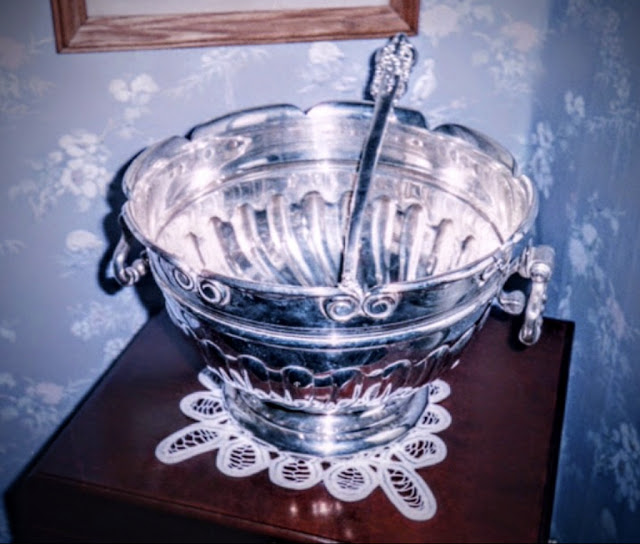Punch-Bowls: Punch bowls of silver are to be noted in most important plate inventories from 1670 until 1820. They were costly to make, the wide-mouthed bowl, measuring 11 to 21 inches in diameter, being raised from a flat disc of silver plate. Three twelve-inch examples struck with the London hallmark for 1666 are in the plate collection of the Skinners' Company.
Early punch bowls followed the pattern of oriental porcelain bowls, being very shallow and very open. Heavy plate was used and the body was more or less a section of a sphere with a plain smooth surface inside and out, not even the rim having any moulding to strengthen it, and was supported on a low, plainly moulded collar foot-ring. In the larger sizes, holding as much as four gallons, the design included two ring handles on the body. The only decoration until about 1715 was an engraved coat of arms or a crest enclosed in a wide border composed of scrells, foliage, flowers and other fashionable motifs. By the end of the seventeenth century it was customary for the rim to be strengthened with a narrow, light rim-moulding, or with a gadrooned or rope pattern edge.
Queen Anne punch bowls introduced a slight elaboration in form: the bowl opening was less expansive than before, and below the rim might be embossed a wide border of vine leaves and fruit, or other ornament. The moulding of the foot-ring was slightly deeper than during the previous century.
Although a considerable number of Georgian punch bowls appear to have been plain-surfaced others were embossed with fluting, which might be wide or narrow, flat-faced or rounded. Melon-shaped flutes are also found, narrow at the base, rising with a right-hand twist and broadening at the rim. Alternate flutes might be heavily embossed with leaf and floral designs. From about 1730 a short spool-shaped stem was placed between foot-ring and bowl, thus lifting the bowl higher from the table. This stem became deeper as the century advanced and the lower ring might be gadrooned.
The bowl rim from about 1730 was slightly incurved, still strengthened by decorative moulding and sometimes with a wide encircling border of chasing or engraving immediately below. This design, with embossed and chased ornament from the rococo to the classic style and back again to the nineteenth century, is characteristic of Georgian punch bowls until 1830. From about 1790 hot punch became fashionable and the punch bowl might be accompanied by a plain circular tray upon which it stood when in use.
Punch-Ladles: Punch drinking so captured the imagination and palate of Georgian society that puncheries were established in their homes, forerunners of the modern cocktail bar. The Georgian punchery was magnificent with its display of colorful punch-bowls, glittering flint-glass goblets, silver spice-dredgers and sugar-bowls, bottles hung with enameled labels naming the numerous liquors from which modish punches were built, and long-handled punch-ladles.
Today, punch-ladles in their changing styles, demonstrating the eye for design and pride in good craftsmanship of the English silversmith, offer interesting possibilities to the small collector. – From Bernard and Therle Hughes”, “Three Centuries of English Domestic Service,” 1952
Punch-Ladles: Punch drinking so captured the imagination and palate of Georgian society that puncheries were established in their homes, forerunners of the modern cocktail bar. The Georgian punchery was magnificent with its display of colorful punch-bowls, glittering flint-glass goblets, silver spice-dredgers and sugar-bowls, bottles hung with enameled labels naming the numerous liquors from which modish punches were built, and long-handled punch-ladles.
Today, punch-ladles in their changing styles, demonstrating the eye for design and pride in good craftsmanship of the English silversmith, offer interesting possibilities to the small collector. – From Bernard and Therle Hughes”, “Three Centuries of English Domestic Service,” 1952
🍽Etiquette Enthusiast, Maura J. Graber, is the Site Editor for the Etiquipedia© Etiquette Encyclopedia

No comments:
Post a Comment
Note: Only a member of this blog may post a comment.